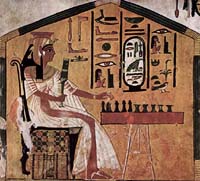Valley of the Queens
 |
| Nefertari |
The Valley of the Queens, also known as Biban el-Harim
, Biban el-Sultanat , and Wadi el-Melikat, is a place in Egypt
where wives of Pharaohs were buried in ancient times. In ancient
times, it was known as Ta-Set-Neferu, meaning –‘the place
of the Children of the Pharaoh’, because along with the Queens
of the 18th, 19th and 20th dynasties (1550–1070 BCE) many
princes and princesses were also buried with various members
of the nobility. The tombs of these individuals were maintained
by mortuary priests whom performed daily rituals and provided
offerings and prayers for the deceased nobility.
The valley is located near the better known Valley
of the Kings, on the west bank of the Nile across from Thebes
(modern Luxor) . This barren area in the western hills was
chosen due to its relative isolation and proximity to the
capital. The kings of the 18th dynasty, instead of the traditional
building of pyramids as burial chambers (perhaps because of
their vulnerability to tomb robbers), now chose to be buried
in rock-cut tombs.
This necropolis is said to hold more than seventy
tombs, many of which are stylish and lavishly decorated. An
example of this is the resting place carved out of the rock
for Queen Nefertari (1290–1224 BCE) of the 19th Dynasty. The
polychrome reliefs in her tomb are still intact.